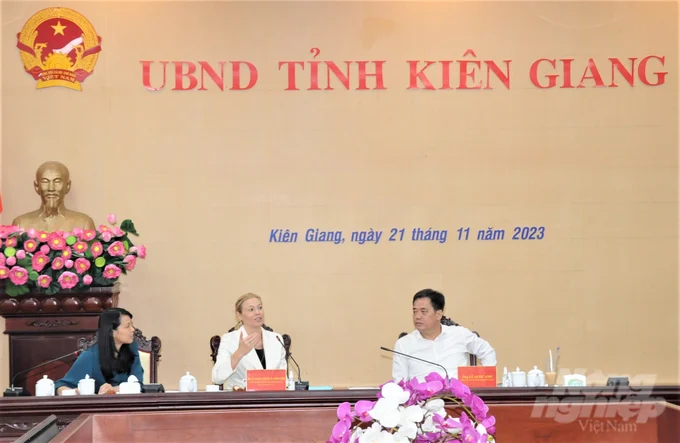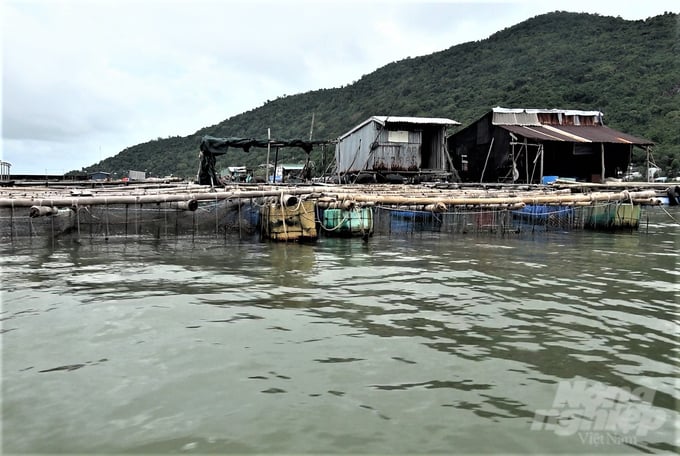November 27, 2025 | 04:06 GMT +7
November 27, 2025 | 04:06 GMT +7
Hotline: 0913.378.918
November 27, 2025 | 04:06 GMT +7
Hotline: 0913.378.918

Ms. Karin Isdahl, Commercial Counselor, Norwegian Embassy Trade Department said, Norway is very interested in developing the fisheries sector. Many Norwegian businesses are present in Vietnam to share and transfer technology to develop marine farming. Photo: Trung Chanh.
On the morning of November 21, at the reception and working session with the Norwegian Embassy delegation led by Ms. Karin Isdahl, Commercial Counselor, Norwegian Embassy Trade Department as head of the delegation, Mr. Le Quoc Anh, Vice Chairman of Kien Giang Provincial People's Committee affirmed: “The province has a large fishing area and many high-value aquatic species. Kien Giang determined that the marine economy would be the main development direction. The province hopes that Norway will support and cooperate in the effective and sustainable development of marine farming in an industrial and modern direction".
Talking to the delegation, Vice Chairman of Kien Giang Provincial People's Committee Le Quoc Anh said: "The European Union (EU) has issued a "yellow card" warning for Vietnam's caught seafood, and we are working hard to remove this "yellow card". Kien Giang will follow the direction of reducing fishing and increasing farming, seeing this as a solution to create jobs and increase income for fishermen.
However, currently, the traditional marine farming profession of Kien Giang fishermen has outdated technology, mainly using homemade cages, and the profession has low tenacity. Therefore, Kien Giang wants Norway to support the development of marine farming, with practical projects that bring practical results. In the immediate future, there may be support for research, potential assessment, and identification of marine farming areas and suitable farming subjects for investment and development.
Kien Giang's strategy is to develop many industries in parallel, developing marine farming accompanying tourism. That means we must apply modern technology and develop marine farming without polluting or affecting the marine tourism environment".
Sharing the same opinion, Mr Le Huu Toan, Deputy Director of the Department of Agriculture and Rural Development of Kien Giang province, said that currently, the province has thousands of marine fish farming cages but on a small scale and with a low output. Kien Giang really wants Norway to support the transfer of marine farming technology, especially HPDE cage technology. HPDE cage is able to withstand storms and reduce emissions and environmental pollution from marine farming activities. Applying information technology in marine farming activities, associated with the development of tourism activities is also important.

Kien Giang hopes Norway will support the transfer of modern marine farming technology to replace traditional cages, in order to develop modern and sustainable marine farming. Photo: Trung Chanh.
According to Mr. Toan, Kien Giang province has a key position for fisheries in the Mekong Delta and the whole country, with the ability to develop the fisheries economy both on the mainland, at sea and on islands. With a large fishing area and many high-value aquatic species, Kien Giang determines that the marine economy will be the main direction of development in the coming time, especially focusing on the effective and sustainable development of marine aquaculture in an industrial and modern direction.
In the first 10 months of 2023, Kien Giang's total marine farming area reached 23,168 ha, with a harvest output of 87,214 tons. Of which, marine fish farming includes 3,837 cages, with an output of 2,993 tons; mollusc farming along the coast and islands operates over an area of 23,168 ha, with an output of 84,221 tons; artificial pearls cultivation operates on an area of 100 ha, with an output of 76,000 pearls/year.
Ms. Karin Isdahl, Commercial Counselor, Norwegian Embassy Trade Department, said that Norway has a very developed salmon farming industry, applying modern technology. Norwegian businesses are very interested in Vietnam, many businesses in the fields of breed production and cage technology are present in Vietnam. If you want to do marine farming, you must invest in technology and ensure biological and disease safety for farmed fish.
However, Kien Giang's current marine farming is only operating near the shore, easily polluted, and not very effective. It is necessary to change technology and farming methods. Another problem is that Vietnam currently does not have national and local marine spatial planning, so handing equipment over the sea surface to implementation units faces many difficulties. This slows the implementation of projects. Marine spatial planning is very important because it involves many fields such as tourism, transportation, and aquaculture.
Translated by Hoang Duy

(VAN) The Mekong River Commission adopts the 2026 - 2030 Strategic Plan with a people-centered approach.
/2025/11/26/1720-1-200855_132.jpg)
(VAN) Viet Nam and Japan have many conditions to expand cooperation on climate change adaptation, particularly in disaster risk management based on advanced technologies.

(VAN) The strong development of digital technology and artificial intelligence is opening up opportunities to transform science and technology into a 'Magic eye' for disaster forecasting and early warning.

Applying vaccines and proactive disease prevention helps pig herds stay healthy, maintain productivity, reduce risks, and decrease reliance on antibiotics in modern livestock farming.

(VAN) Many advanced agricultural technologies and products were shared at the Viet Nam - South Korea Agricultural Technology Introduction, Trade Promotion, and Connection Seminar 2025.

(VAN) Minister Tran Duc Thang hopes to strengthen connections and exchanges with China in agriculture and environment sector through the Embassy of Vietnam in Beijing.

(VAN) After 50 years of strategic cooperation, Viet Nam and UNICEF remain committed to promoting fair and inclusive development for all children in the digital future.